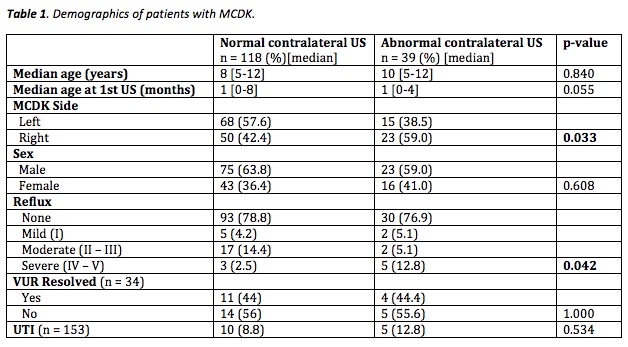Role Of VCUG And Importance Of VUR In Follow Up Of Patients With MCDK
Michelle Camp, M.S.1, Natalia Ballesteros, M.D.2, Ruben Blachman, M.D.2, Camila Velasquez, M.D.2, Iuri Dutra, M.D.2, Paulo Moscardi, M.D.2, Mariarita Salvitti, M.D.2, Kristin Kozakowski, M.D.2, Miguel Castellan, M.D.2, Rafael Gosalbez, M.D.2, Andrew Labbie, M.D.2, Ricardo Restrepo, M.D.2, Alireza Alam, M.D.2.
1University of Miami Miller School of Medicine, Miami, FL, USA, 2Nicklaus Children's Hospital, Miami, FL, USA.
BACKGROUND:
Vesicoureteral reflux (VUR) is seen in up to 25% of children with multicystic dysplastic kidney (MCDK). After confirming MCDK on ultrasound (US) a voiding cystourethrogram (VCUG) is traditionally obtained in every patient. However, VCUG is invasive, painful, expensive, and also predisposes to UTIs. More recently, retrospective studies have shown a low incidence of clinically significant VUR in children with unilateral MCDK who have a normal contralateral kidney on US and clinicians continue to question the utility of routine VCUG in this setting. However, little has been studied as to the utility of VCUG in MCDK patients with an abnormal contralateral kidney. Our objective is to assess the value of VCUG in determining the likelihood of VUR in all MCDK patients, as well as the clinical significance of VUR.
METHODS:
A retrospective chart review of pediatric patients with a diagnosis of MCDK from 2008-2017 was performed. Inclusion criteria were patients with MCDK who had a normal or abnormal contralateral postnatal US, in addition to a VCUG. Patients who did not meet MCDK criteria, including those with function in the dysplastic kidney as well as those without an US or VCUG, were excluded.
RESULTS:
Of 245 children with MCDK, a total of 157 patients were analyzed, of which 118 had a normal contralateral US (table 1). Of these, 25 (21.2%) had VUR, with 19 (76%) in the contralateral kidney. Of the 3 patients with severe VUR (grade IV-V), 1 was to the MCDK, 1 to the contralateral kidney, and the last was bilateral and more severe to the MCDK side. Three of these 25 patients with VUR had a documented UTI, one being severe (grade IV). Of the 39 with an abnormal contralateral US, 9 patients (12 renal units) had VUR (23%) with 6 of them (6 renal units) in the contralateral kidney (66.7%) (Table 1). Two of these 9 patients with VUR had a documented UTI, one severe (grade V, bilateral) and one moderate (grade III). In the overall population for which UTI was documented (n=153), there was no statistical significance when comparing the risk of UTI in relation to age, abnormal US or VUR. However, females had a higher frequency of UTI (p=0.002). Additionally, there was no statistically significant difference in the rate of UTI between VUR patients with a normal versus abnormal contralateral kidney on US (p = 0.604).
CONCLUSIONS:
Our findings conclude that in patients with MCDK, diagnosing VUR via VCUG may not have much utility, as the risk of UTI was not statistically significant, regardless of a normal or abnormal contralateral kidney on US. Based on our results, it may be better to follow MCDK patients only with ultrasonography and observe them for signs or symptoms of UTI development. 
Back to 2018 Program




